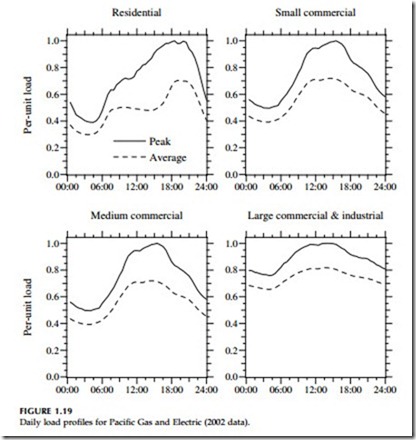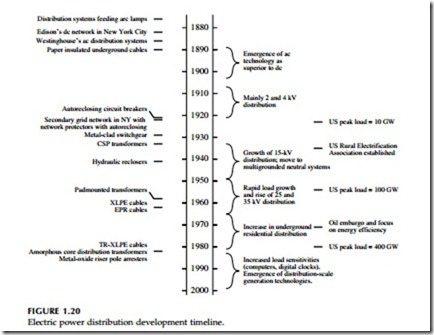The Past and the Future
Looking at Seelye’s Electrical Distribution Engineering book (1930), we find more similarities to than differences from present-day distribution systems. The basic layout and operations of distribution infrastructure at the start of the 21st century are much the same as in the middle of the 20th century. Equipment has undergone steady improvements; transformers are more efficient; cables are much less expensive and easier to use; and protection equipment is better (see Figure 1.20 for some development milestones). Utilities operate more distribution circuits at higher voltages and use more underground circuits. But the concepts are much the same: ac, three-phase systems, radial circuits, fused laterals, overcurrent relays, etc. Advances in computer technology have opened up possibilities for more automation and more effective protection.
How will future distribution systems evolve? Given the fact that distribu- tion systems of the year 2000 look much the same as distribution systems in 1950, a good guess is that the distribution system of 2050 (or at least 2025) will look much like today’s systems. More and more of the electrical infra- structure will be placed underground. Designs and equipment will continue
to be standardized. Gradually, the distribution system will evolve to take advantage of computer and communication gains: more automation, more communication between equipment, and smarter switches and controllers. EPRI outlined a vision of a future distribution system that was no longer radial, a distribution system that evolves to support widespread distributed generation and storage along with the ability to charge electric vehicles (EPRI TR-111683, 1998). Such a system needs directional relaying for reclosers, communication between devices, regulators with advanced controls, and information from and possibly control of distributed generators.
Advances in power electronics make more radical changes such as con- version to dc possible. Advances in power electronics allow flexible conversion between different frequencies, phasings, and voltages while still Distribution systems feeding arc lamps Edison’s dc network in New York City Westinghouse’s ac distribution systems Paper insulated underground cables
producing ac voltage to the end user at the proper voltage. While possible, radical changes are unlikely, given the advantages to evolving an existing system rather than replacing it. Whatever the approach, the future has chal- lenges; utilities will be expected to deliver more reliable power with minimal pollution while keeping the distribution system hidden from view and caus- ing the least disruption possible. And of course, costs are expected to stay the same or go down.

